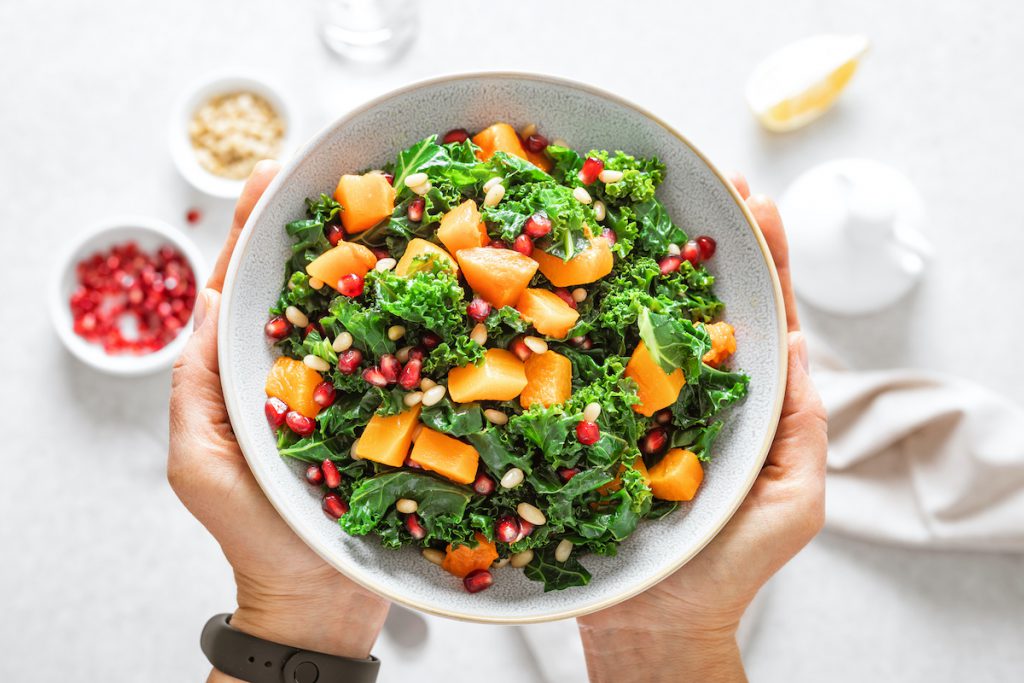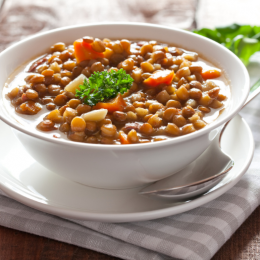12 maneras fáciles para que las ensaladas sean exquisitas (en serio)
Take your salad combos from “meh” to memorable with these nutritionist-approved tips.

There are lots of healthy dishes, but few stand out more than salads. This lunchtime staple is a fall-back way to load up your diet with more nutrient-rich vegetables for healthier aging.
But if you are like most Americans, you can likely benefit from eating more veggies on any given day. Only one in 10 Americans can say they're hitting the federal recommendations for daily vegetable consumption, which is at least 2 to 3 cups, according to the Centers for Disease Control and Prevention.
The thing is, not everyone is excited to sit down at the table and eat a salad. We get it: It's easy to think of them as boring - something you only eat because you know you should. And it doesn't help that the stereotypical salad isn't much more than limp leaves and lackluster dressing.
It's time to drop the notion that salads are a snore. We're breaking down 12 ways to make your next salad sing - with easy-to-implement strategies to wake them up.
1. Make Your Salad a Spectacle
A favorite adage among chefs is, “You eat with your eyes first.” If your salad combo looks appealing, it will actually be more tempting to eat, according to research in the journal Physiology & Behavior. Turns out that visual presentation has the power to modify the way taste, odor, and flavor are perceived.
In other words: Looks matter.
“When your salad looks pretty, you certainly have a greater desire to eat it,” says Toby Amidor, a registered dietitian in Scarsdale, New York, and author of The Family Immunity Cookbook.
Amidor says one of the easiest ways to doll-up salads is to choose a variety of different-colored ingredients. Luckily, veggies come in a rainbow of hues, including yellows, reds, greens, and purples. Try swapping out your usual orange carrots for vibrant purple ones or grabbing a package of multicolored tomatoes.
Don’t stop with the food swaps: Something as simple as using a fancy bowl, or arranging your ingredients with a decorative touch, can also help you stay excited about eating your veggies.
2. Mix and Match Leaves
If you always use the same base of romaine or spinach leaves, it's time to switch things up. "Try tossing together two or more different greens to give your salads more exciting tastes and textures," says Amidor.
Even if two greens look similar, they have unique flavors, she explains. Arugula, frisée, and radicchio, for example, have bold tastes and can punch up romaine and iceberg lettuce.
“You can also sauté spinach, kale, or collard greens and add those to your salad for a different texture and flavor,” she adds.
Or forgo leafy greens completely from time to time. One combo she recommends: Tomato wedges paired with, shredded carrots or Brussels sprouts, or shaved broccoli.
3. Upgrade Your Salad Dressings
We're not knocking the trusty oil-and-vinegar formula, but it's good to have a few more go-to options, says Melissa Joy Dobbins, a registered dietitian who runs Sounds Bites in Chicago. A few ideas to add to your oil-and-vinegar mix:
- Citrus zest
- Grainy mustard
- Grated fresh ginger
- Minced anchovies
- Miso
- Red chili flakes
- Splash of pomegranate juice
- Tamari
You can also experiment with different vinegars, says Dobbins. Fan of raspberry vinaigrette? You might like the mild, floral flavor of champagne vinegar. Love olive oil? Swap in a savory avocado, walnut, or sesame oil. Embellish creamy dressings with tahini, kefir, almond butter, or even hummus.
4. Massage Your Salad Greens
Yes, this tip is exactly as it sounds: When using sturdy greens like kale, Swiss chard, and cabbage, go ahead and "massage" the leave and dressing together with your clean hands. (Be sure to remove the tough stems first.) Do this for a minute or two to infuse the flavors of the dressing directly into the vegetables.
Massaging also helps to soften the greens and minimizes any bitter flavors. This trick works for both vinaigrettes and creamy dressings.
5. Toss in Cooked Veggies
Remember, salad doesn't have to be a raw-veggies-only affair. "Including cooked veggies is a great way to use up leftovers and add more nutrition to your salad," says Dobbins. Not to mention making your salad more dynamic and super satisfying.
Roasted vegetables to toss in:
- Acorn or butternut squash
- Beets
- Brussels sprouts
- Rutabaga
- Sweet potatoes
Grilled vegetables to toss in:
- Bell peppers
- Eggplant
- Red onion
- Zucchini
6. Add Fresh Herbs
This is one of the easiest ways to add some punch and brightness to your salad, says Dobbins. Herbs also provide an added boost of vitamins and disease-fighting antioxidants, she adds. Her favorites for salads are dill, cilantro, chives, basil, mint, and parsley.
If your local grocery store has broccoli and pea "microgreens," grab them, she adds. Microgreens are young vegetables and herbs that are not much older than seedlings. They're loaded with intense flavors, colors, and unique textures.
But what really makes them a good salad addition is their nutritional makeup. Ounce for ounce, microgreens contain a more concentrated dose of key nutrients, including vitamin C, beta-carotene, and vitamin K, than mature vegetables, according to researchers from the U.S. Department of Agriculture (USDA).
7. Sweeten with Fruit
Adding fruit is another way to up the fiber and phytonutrients in your salads, says Amidor. Go with whatever is fresh and in-season. Also keep in mind the dressing you've chosen - sweeter fruits, like berries and grapes, balance out a tangier dressing.
Amidor’s top salad fruits:
- Bayas
- Citrus fruits, including blood oranges and kumquats
- Mango
- Pear
- Plum
- Pomegranate seeds
Strawberries and cherries can also be blended into vinaigrettes. And don't overlook dried fruits, such as golden raisins, apricots, and figs to add a pop of sweetness.
8. Heat Your Salad Dressing
There's no rule saying that salad dressings must always be cold or at room temperature. If you're making a kale-based salad, for example, a warm dressing can gently wilt some of the greens, which many people find a more satisfying texture to bite into.
Some dressings work much better for this than others. Anything creamy is a no-go. But oil-and- vinegar dressings are ideal for this tip. Warm them on the stovetop in a small pot on low heat. You can also microwave dressing in a microwave-safe bowl: Use a medium power for a few seconds at a time until you've reached the desired temperature.
Suscríbase a nuestro boletín informativo
Es rápido y fácil: Usted podría estar entre las 13 millones de personas elegibles.
¿Ya es miembro? Haga clic para descubrir nuestros más de 15,000 centros participantes.
Síganos
9. Make Salad a Main Dish
One of the best ways to get excited to dig into a salad is to transform it from a mere side-dish to the star of the show, says Amidor.
"When you're thinking of salad as a meal, it just means including more food groups, so you get all your fiber and nutrition needs," she explains. "As a bonus, a heartier salad will help keep you feeling fuller for longer."
She suggests looking at a salad as you would look at the USDA’s MyPlate:
- Vegetables and fruits should make up half the salad
- Protein fills one-quarter of the bowl
- Whole grains fill the remaining quarter
Good protein options for salads include: cooked chicken or steak, beans, hard-boiled egg, canned fish, lentils, edamame, and seared tofu. For your whole grain, you can add quinoa or brown rice. Or, make your own whole-grain croutons by toasting a sturdy bread like rye.
“Making a salad can also be a way to get your creative juice flowing by using leftovers in your pantry or refrigerator,” says Amidor.
10. Think Beyond Lettuce
If you feel like you're in a salad rut, get more creative with the veggies you are using. That means exploring less-known options like endives, dandelion greens, celery root, baby Bok choy, and jicama.
Not only will these unexpected options surprise your taste buds, but Amidor notes that different vegetables have different nutrients. "To get a more balanced diet, you want to include a variety of foods in your meals each week," she explains.
Not sure where to start? Head to your local farmer's market to scope out what's in season and what might be new to you. Sellers often allow taste testing, and usually have handy prep tips.
11. Play with Textures
"Salads provide the perfect vehicle for a variety of textures, which can make your salad more interesting and therefore make you want to eat more of them," notes Dobbins. "Try dried fruit for chewy texture; nuts or seeds for a crunch; and cottage cheese, goat cheese, or avocado for a creamy element."
How you prepare your veggies also impacts the texture of the final dish. Beets, broccoli, parsnips, and carrots can all be shredded first. Or chop up pickled beets, jarred roasted red peppers, or marinated artichoke hearts for a seesaw of both flavors and texture.
12. Include Surprising Flavors
Finally, you can make your salads really crave-worthy by including unexpected flavors. Think cubes of smoked cheese or chunks of smoked fish. Other add-ins to try: briny olives, salty capers, tangy sauerkraut, full-flavored blue cheese or gorgonzola, or a spoonful of jarred mango chutney.
It’s all about adding a bit of wow factor to make it even more appetizing to have salads on your daily menu.
¡Tome en línea sus clases favoritas de SilverSneakers!
SilverSneakers members can access live fitness classes and wellness workshops through SilverSneakers LIVE. See the latest schedule and RSVP for classes here.
Not a member? If you have a Medicare Plan, it may include SilverSneakers — at no additional cost. Verifique su elegibilidad al instante aquí.





